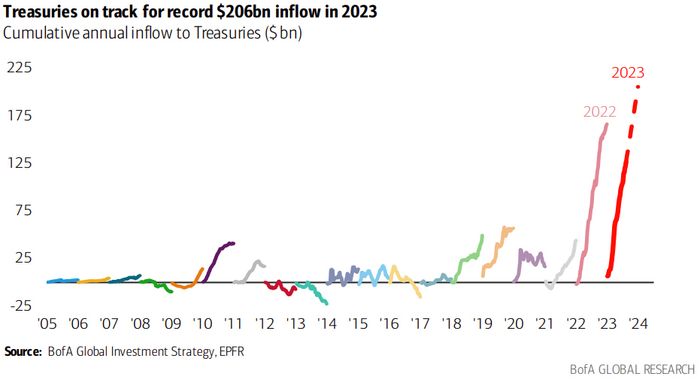Treasury auctions end on a downbeat note this week after soft 30-year sale

The Treasury market ended the week on a somewhat downbeat note after struggling to absorb Thursday’s $23 billion auction of 30-year bonds despite a record pace of investor inflows.
Demand for the auction was described by strategists and traders as “so-so,” “soft” and “weaker-than-expected.” Thursday’s disappointing sale overshadowed July’s consumer-price report and was the main reason that investors and traders sold off long-dated Treasurys that same afternoon.
The selloff in long-dated U.S. government debt extended into Friday — pushing the 10-year yield BX:TMUBMUSD10Y and 30-year rate BX:TMUBMUSD30Y to one-week highs of 4.166% and 4.271%, respectively — and comes at a time when Treasurys are on track for what BofA Securities strategists see as a record $206 billion of inflows this year. Greater inflows should be pushing yields lower, not higher, but that’s not happening. Instead, yields are rising anyway.

Demand/supply dynamics in the Treasury market have recently changed and “the balance of power seems to be shifting in favor of higher yields” at a time of “runaway” government deficits and increases in Treasury’s debt issuances, said Marios Hadjikyriacos, a senior investment analyst at Cyprus-based multiasset brokerage XM.
In a note on Friday, the analyst said that the soft 30-year Treasury auction “certainly reinforced this notion yesterday, helping to propel yields higher,” alongside commentary from San Francisco Fed President Mary Daly, who said the central bank has more work to do to get inflation down.
This week’s government auctions were seen as a key test as to whether investors could keep up their demand for U.S. government debt amid a deluge of issuance and worries about the fiscal outlook. However, liquidity during August tends to be low so Thursday’s poorly received 30-year sale is not necessarily indicative of further trouble ahead, considering Wednesday’s $38 billion auction of 10-year notes and Tuesday’s sale of $42 billion in 3-year notes both went well, according to analysts.
On July 31, the Treasury Department released an eye-popping $1 trillion borrowing estimate for the third quarter, which was followed the next day by Fitch Ratings’ decision to cut the government’s top AAA rating. Worries about the trajectory of U.S. finances then spilled into Thursday’s 30-year bond auction.
“The technical picture of the Treasury market heading into auctions this week was weak, and it’s not terribly good right now in the long end after the 30-year sale,” said Gregory Faranello, Head of U.S. Rates for AmeriVet Securities in New York. “The auction wasn’t bad, it just wasn’t as strong as the three-year or 10-year sales on Tuesday and Wednesday.”
At a time when the fiscal outlook looks worrisome, Federal Reserve policy makers are raising interest rates and shrinking the central bank’s $8.2 trillion balance sheet. In other words, the Fed, long seen as an important buyer of Treasurys which isn’t price-sensitive, “has gone away and the buyers left now are more price sensitive,” Faranello said via phone.
“If we put all these factors into a blender, for the first time in 10 to 15 years they’re all pointing in the same way and that’s pressure on yields regardless of the inflows that come and go,” he said, adding that even financial-stability issues in March weren’t enough to keep Treasury rates down. “Ultimately, the only reasons that yields would go lower from here is weak economic data, which we don’t have, or central bank policy which changes course. The stars are aligning the other way not just here in the U.S., but globally.”
The yield awarded at Thursday’s 30-year auction was higher than what it was going into the competitive deadline, which means demand wasn’t great. In addition, primary dealers were awarded a higher percentage of the allotment than last month, meaning “people on the sidelines didn’t show up or have much interest,” said macro strategist Will Compernolle of FHN Financial in New York. The poor reception “seemed to surprise most people and I think it’s carried on into today.”
On Friday, traders and investors continued to sell off most Treasurys after July’s producer-price report surprised to the upside. Two-, 10- and 30-year yields all ended the week higher. Meanwhile, U.S. stocks finished mostly lower, with the S&P 500 SPX and Nasdaq Composite COMP down for the day.
By: Vivien Lou Chen



